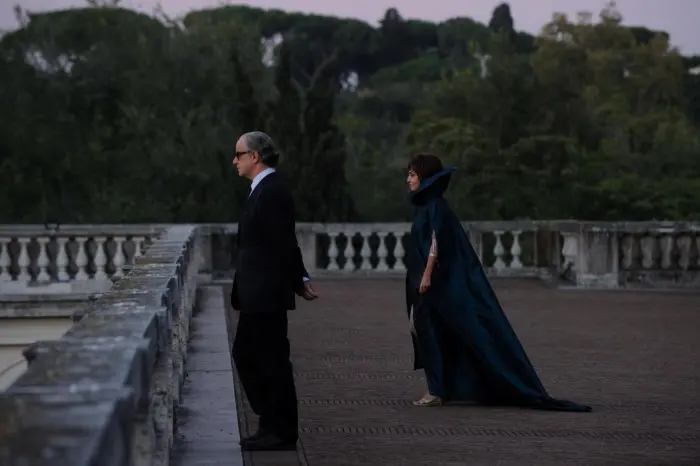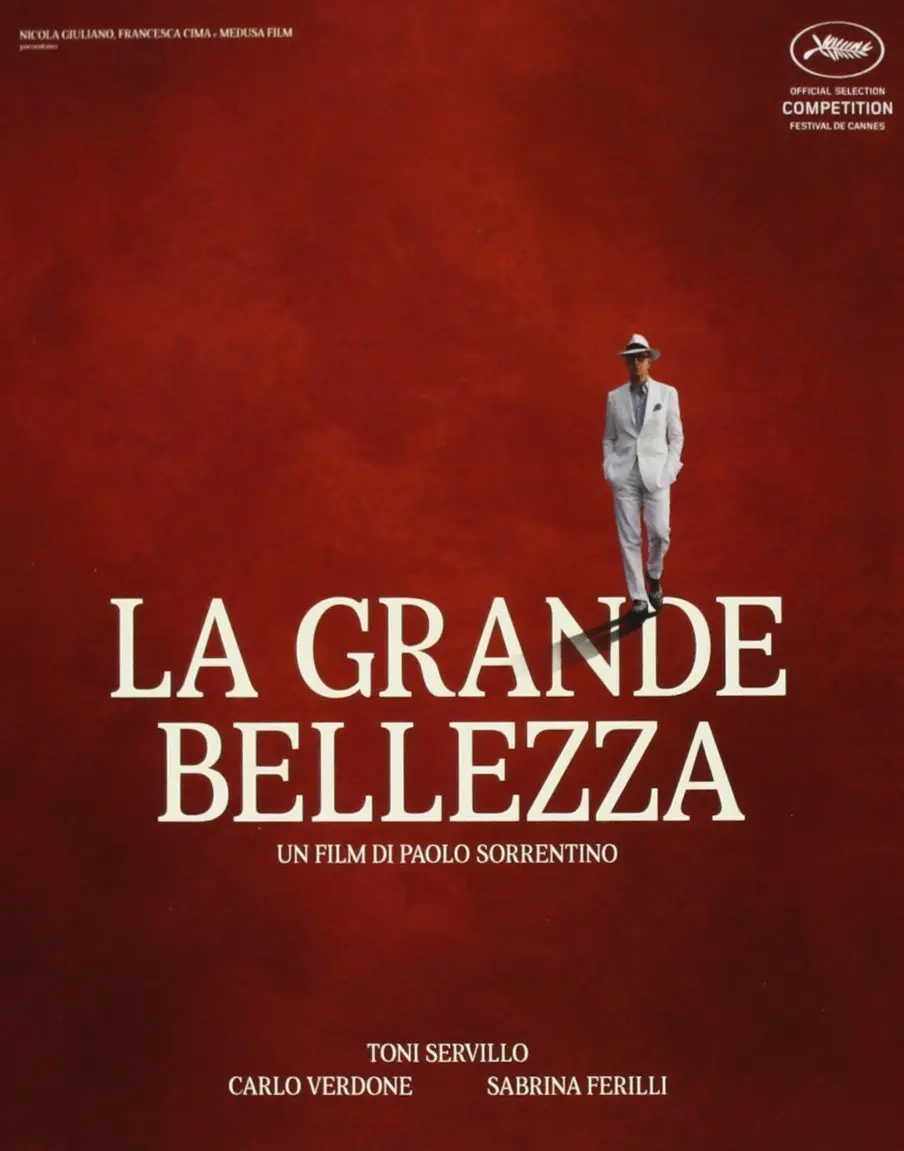

The Great Beauty is a declaration of love by Paolo Sorrentino for Rome, which is not presented through images of its most renowned sights, which can be glimpsed only in the background of the shots, but through the historical buildings and streets winding through the city centre, pausing on the distinguishing features of its gardens. It surprises us at night, or at dawn, as Jep walks home after the umpteenth pointless party of the elite. It is a beauty that contrasts with the vulgarity of the characters, who move around the city like caricatures without really grasping its essence, an essence which however does not escape the Japanese tourist who faints whilst admiring the view from the piazza in front of the Acqua Paola Fountain. The “Fontanone” surmounts the complex of San Pietro in Montorio, with the Tempietto del Bramante, where Jep sees a little girl hiding from her mother.
During these meanderings we see Jep on Aventine Hill, near the Basilica of Santa Sabina and the Orange Garden; we see him walking along the banks of the Tiber, focused on admiring an unusual view of the city; or in the crumbling Via Veneto, which is traversed by a few wealthy Chinese and Arab tourists and couldn’t be further removed from the splendour of La Dolce Vita.
The scenes in the film that focus on the night life of Jep Gambardella and his collection of friends take place essentially on two terraces: one of these, near Via Veneto, hosts Jep’s birthday party; the other, the private terrace of the protagonist, sits atop a building that looks over the ruins of the Temple of Claudius in Celio, on one side, and the Colosseum on the other.
Nothing is left to chance, not even the private apartments of the characters. Orietta, with whom Jep has a fleeting relationship, lives in the Pamphilj Palace in Piazza Navona: the film chooses not to show its prestigious gallery, which is home to several works including the famous Stories of Enea frescoes, the Baroque masterpiece of Pietro da Cortona. The lavish Palazzo Sacchetti is instead the setting for Viola’s home. It is located in Via Giulia and is one of the most extraordinary examples of Renaissance architecture, designed by the architect Antonio da Sangallo. Inside, in a long corridor adorned with busts, Andrea, the son of Viola, painted red from head to toe, starts a surreal conversation with his mother.
The façade of the palace, through a clever bit of editing, introduces us to the main floor of Palazzo Taverna, which is actually near Piazza dell’Orologio. Inside, one of the most melancholic scenes of the film takes place: the Colonna di Reggio, fallen aristocrats, are returning from an evening for which Jep “hires” them to make an impression on his illustrious guests. The princess decides to hang back to visit the museum that was once her home on her own: we see her in front of the crib she was born in, while a voiceover tells her story.
One of the more evocative sequences in the film sees Jep’s friend Stefano, the owner of the keys to the most beautiful buildings in Rome, accompany Jep and Ramona on a night-time tour of some of the city’s more enchanting locations. The cameras show us the statues of the Capitoline Museums in Palazzo Nuovo; they take us to Aventine Hill, where, after walking through the door with the famous keyhole you can see Saint Peter’s Basilica through (which is also a fictional element of the film as the door cannot actually be opened), the three characters find themselves in one of the most mysterious places in Rome, the garden of the Villa del Priorato dei Cavalieri di Malta. The tour continues to Palazzo Barberini, where we can admire Raphael’s Portrait of a Young Woman, lit up by the weak light from the candelabra in the hands of Stefano, and then into the courtyard of Palazzo Spada, where we are tricked by the “forced perspective” of the gallery, which is 8 metres long (but seems a lot longer), finishing up at dawn in the garden of Villa Medici, which currently houses the French Academy.
This fascinating and non-exhaustive overview of locations can’t end without mentioning the Parco degli Acquedotti, where Jep sceptically watches the extreme performance of Talia Concept, who, naked, throws herself against the stones of the Claudio Acqueduct. Then there’s Bramante’s Tempietto, in the underground passageways of which a young girl hides from her mother as she worriedly looks for her, the Salon of the EUR, where the luxury clothing store in which Ramona chooses the right outfit for the funeral of Viola’s son is set, the Basilica of San Lorenzo in Lucina, where the funeral service is held, Villa Giulia, whose covered walkways of which host the exhibition by Ron Sweet, and the Baths of Caracalla, where a giraffe magically disappears from our sight.
The scenes set at the sea, where Jep meets his one great love, were filmed on Giglio Island, at the Capel Rosso lighthouse.
The Great Beauty is a declaration of love by Paolo Sorrentino for Rome, which is not presented through images of its most renowned sights, which can be glimpsed only in the background of the shots, but through the historical buildings and streets winding through the city centre, pausing on the distinguishing features of its gardens. It surprises us at night, or at dawn, as Jep walks home after the umpteenth pointless party of the elite. It is a beauty that contrasts with the vulgarity of the characters, who move around the city like caricatures without really grasping its essence, an essence which however does not escape the Japanese tourist who faints whilst admiring the view from the piazza in front of the Acqua Paola Fountain. The “Fontanone” surmounts the complex of San Pietro in Montorio, with the Tempietto del Bramante, where Jep sees a little girl hiding from her mother.
During these meanderings we see Jep on Aventine Hill, near the Basilica of Santa Sabina and the Orange Garden; we see him walking along the banks of the Tiber, focused on admiring an unusual view of the city; or in the crumbling Via Veneto, which is traversed by a few wealthy Chinese and Arab tourists and couldn’t be further removed from the splendour of La Dolce Vita.
The scenes in the film that focus on the night life of Jep Gambardella and his collection of friends take place essentially on two terraces: one of these, near Via Veneto, hosts Jep’s birthday party; the other, the private terrace of the protagonist, sits atop a building that looks over the ruins of the Temple of Claudius in Celio, on one side, and the Colosseum on the other.
Nothing is left to chance, not even the private apartments of the characters. Orietta, with whom Jep has a fleeting relationship, lives in the Pamphilj Palace in Piazza Navona: the film chooses not to show its prestigious gallery, which is home to several works including the famous Stories of Enea frescoes, the Baroque masterpiece of Pietro da Cortona. The lavish Palazzo Sacchetti is instead the setting for Viola’s home. It is located in Via Giulia and is one of the most extraordinary examples of Renaissance architecture, designed by the architect Antonio da Sangallo. Inside, in a long corridor adorned with busts, Andrea, the son of Viola, painted red from head to toe, starts a surreal conversation with his mother.
The façade of the palace, through a clever bit of editing, introduces us to the main floor of Palazzo Taverna, which is actually near Piazza dell’Orologio. Inside, one of the most melancholic scenes of the film takes place: the Colonna di Reggio, fallen aristocrats, are returning from an evening for which Jep “hires” them to make an impression on his illustrious guests. The princess decides to hang back to visit the museum that was once her home on her own: we see her in front of the crib she was born in, while a voiceover tells her story.
One of the more evocative sequences in the film sees Jep’s friend Stefano, the owner of the keys to the most beautiful buildings in Rome, accompany Jep and Ramona on a night-time tour of some of the city’s more enchanting locations. The cameras show us the statues of the Capitoline Museums in Palazzo Nuovo; they take us to Aventine Hill, where, after walking through the door with the famous keyhole you can see Saint Peter’s Basilica through (which is also a fictional element of the film as the door cannot actually be opened), the three characters find themselves in one of the most mysterious places in Rome, the garden of the Villa del Priorato dei Cavalieri di Malta. The tour continues to Palazzo Barberini, where we can admire Raphael’s Portrait of a Young Woman, lit up by the weak light from the candelabra in the hands of Stefano, and then into the courtyard of Palazzo Spada, where we are tricked by the “forced perspective” of the gallery, which is 8 metres long (but seems a lot longer), finishing up at dawn in the garden of Villa Medici, which currently houses the French Academy.
This fascinating and non-exhaustive overview of locations can’t end without mentioning the Parco degli Acquedotti, where Jep sceptically watches the extreme performance of Talia Concept, who, naked, throws herself against the stones of the Claudio Acqueduct. Then there’s Bramante’s Tempietto, in the underground passageways of which a young girl hides from her mother as she worriedly looks for her, the Salon of the EUR, where the luxury clothing store in which Ramona chooses the right outfit for the funeral of Viola’s son is set, the Basilica of San Lorenzo in Lucina, where the funeral service is held, Villa Giulia, whose covered walkways of which host the exhibition by Ron Sweet, and the Baths of Caracalla, where a giraffe magically disappears from our sight.
The scenes set at the sea, where Jep meets his one great love, were filmed on Giglio Island, at the Capel Rosso lighthouse.

Jep Gambardella, who wrote a book during his youth, and is a journalist by habit, defines himself as “the king of the elite”. He’s a regular fixture at parties and evenings spent with his snob friends.